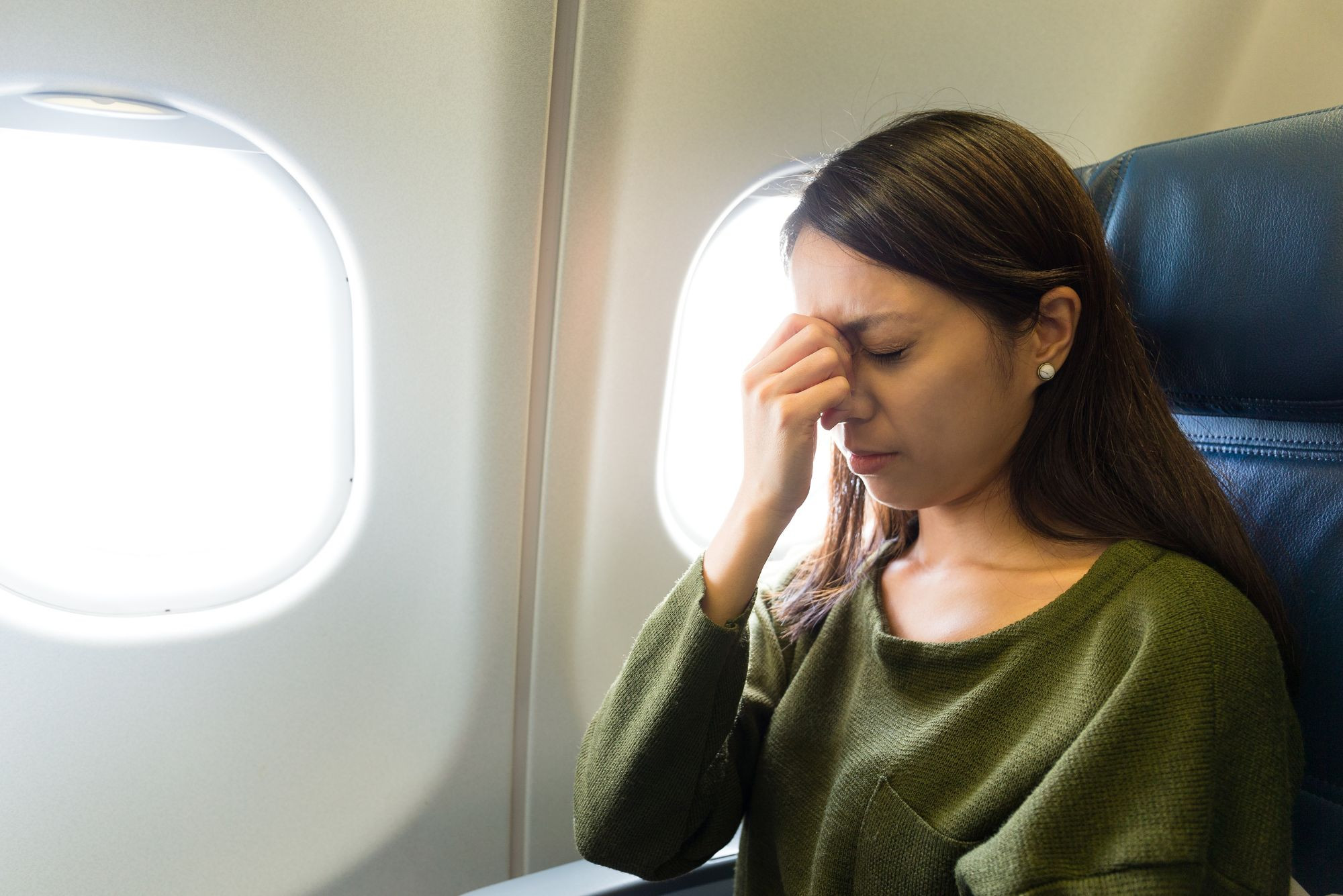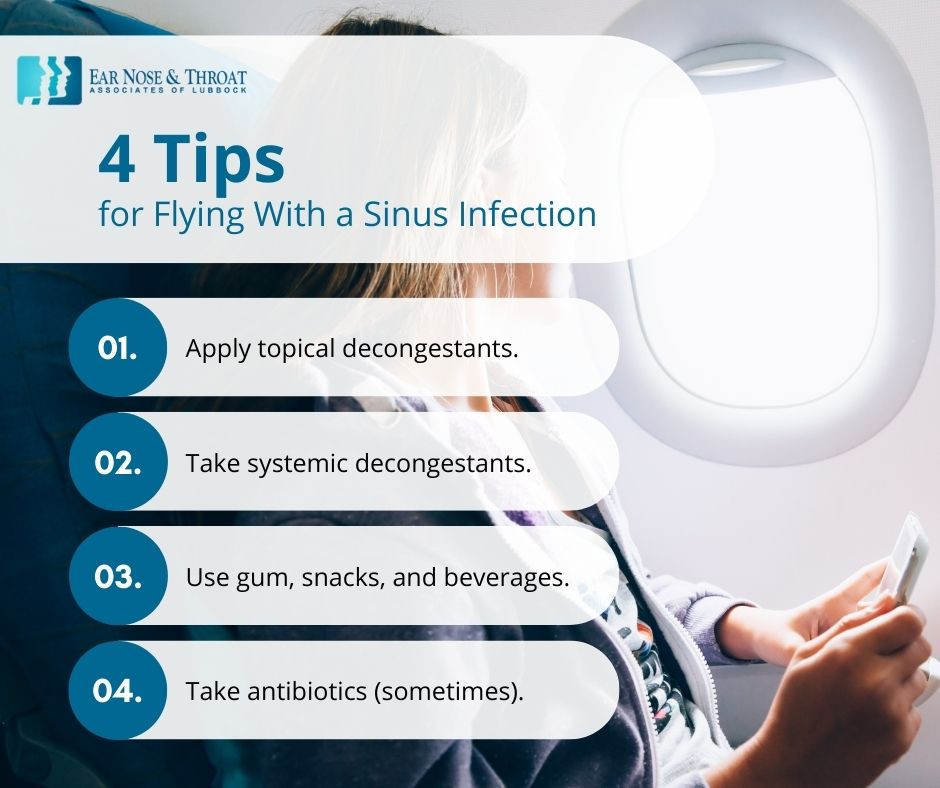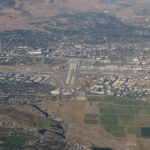Flying with a sinus infection can transform your travel experience from exciting to excruciating. The pressure changes in the cabin during ascent and descent can amplify sinus pain, making what should be a smooth flight feel like torture. But is it safe to fly with sinusitis, and more importantly, how can you minimize discomfort if you must travel?
This guide, crafted by medical content specialists, will delve into why flying with sinusitis hurts and provide actionable strategies to make your journey more bearable. We’ll explore expert-backed tips to help you manage sinus pressure and ensure you reach your destination feeling as well as possible.
Understanding Why Sinus Infections Cause In-Flight Pain
The primary reason flying becomes painful with a sinus infection isn’t the infection itself, but the pressure fluctuations inherent to air travel.
 Woman experiencing sinus pain while flying due to a sinus infection.
Woman experiencing sinus pain while flying due to a sinus infection.
Sinuses are essentially air-filled pockets located within your skull, connected to your nasal passages by small channels. When these channels are clear, air and mucus can flow freely, equalizing pressure. However, a sinus infection causes inflammation and swelling, often blocking these drainage pathways. This blockage traps air and mucus inside the sinuses.
During takeoff and landing, the atmospheric pressure inside the airplane cabin changes rapidly. In healthy sinuses, air pressure adjusts easily. But with blocked sinuses, the pressure inside can’t equalize with the cabin pressure. This pressure difference is what causes that intense, often sharp pain you might experience.
This pressure issue is similar to what happens with ear pain during flights. The middle ear connects to the back of the nose via the Eustachian tube, which can also become congested due to a sinus infection, hindering pressure equalization and causing discomfort.
The following tips are aimed at reducing this blockage, helping to alleviate sinus pressure and pain during air travel.
 Infographic: 4 tips from a doctor to relieve sinus pressure when flying with a sinus infection, including decongestants, gum, and antibiotics.
Infographic: 4 tips from a doctor to relieve sinus pressure when flying with a sinus infection, including decongestants, gum, and antibiotics.
Top Strategies to Relieve Sinus Pressure During Flights
Here are four effective methods to help manage sinus pain and pressure when flying with sinusitis:
1. Utilize Topical Nasal Decongestants
Topical decongestants, such as nasal steroid sprays, offer rapid relief from nasal congestion. Available over the counter, these sprays can quickly reduce swelling in your nasal passages and sinus openings. By clearing these pathways, they can help restore pressure equalization and lessen pain during flights.
It’s recommended to use a topical decongestant approximately 30 minutes before your flight takes off. This allows sufficient time for the medication to take effect and open up your sinus passages before pressure changes become significant.
However, it’s crucial to remember that topical decongestants are designed for short-term use. Prolonged use beyond three days can lead to rebound congestion, actually worsening your symptoms. Use them judiciously, specifically for travel days.
Common options include oxymetazoline (Afrin), but even a simple saline nasal spray or rinse can be beneficial for some. Saline solutions help to moisturize nasal passages and can gently clear congestion without the risk of rebound effects.
2. Consider Systemic Decongestants
Systemic decongestants, typically available as pills, are another over-the-counter option to combat nasal and sinus congestion. These medications work by being absorbed into your bloodstream and reducing swelling throughout your body, including your nasal passages and sinuses.
Popular brands like Sudafed, Allegra D, and Claritin D often contain pseudoephedrine or phenylephrine, systemic decongestants that can help alleviate congestion and potentially open up Eustachian tubes and sinus pathways.
However, systemic decongestants may not be suitable for everyone. Individuals with high blood pressure or heart conditions should exercise caution, as these medications can elevate blood pressure and heart rate. If you have such health concerns, consult your doctor before using systemic decongestants or explore alternative home remedies for sinus relief.
3. Chew Gum, Snack, and Hydrate
Simple actions like chewing gum, snacking, and drinking beverages can be surprisingly effective in alleviating ear and sinus pressure during flights. Chewing gum is a well-known trick to help your ears “pop” and equalize pressure as cabin pressure changes.
This “popping” sensation occurs when your Eustachian tubes open up due to swallowing and chewing motions, allowing air pressure in your middle ear to adjust. While primarily known for ear pressure relief, the act of swallowing can also subtly aid in sinus drainage and pressure regulation.
If gum isn’t your preference, eating snacks or drinking water can provide similar benefits. Frequent swallowing, regardless of the cause, encourages Eustachian tube function and pressure equalization. Staying hydrated is also beneficial as it helps to thin mucus secretions, potentially improving sinus drainage.
4. Discuss Antibiotics with Your Doctor (When Appropriate)
If you have an upcoming flight and are battling a sinus infection, antibiotics might be a consideration, but only under specific circumstances. Antibiotics are only effective against bacterial sinus infections, not viral ones, which are the more common cause of sinusitis.
The majority of sinus infections are viral and typically resolve within 7 to 10 days with supportive care like over-the-counter medications and home remedies. However, if your sinus infection persists beyond 10 days, or if you experience severe symptoms such as intense facial pain, high fever, or thick nasal discharge, a bacterial infection might be present.
In such cases, consulting your doctor is crucial. If a bacterial infection is diagnosed, antibiotics may be prescribed. However, antibiotics are not a quick fix and require several days to become fully effective. It’s best to start antibiotics well in advance of your flight, if possible, and only under medical advice.
Before You Fly: Confirm It’s Sinusitis
The symptoms of sinus infections can overlap with other conditions like colds, flu, allergies, and even COVID-19. Before assuming you have a sinus infection and taking measures to fly with it, it’s important to ensure you are correctly diagnosed.
Accurate diagnosis is crucial not only for your comfort but also for public health, especially when considering air travel. If you’ve had sinus symptoms for more than a week, or if they are severe, consult your doctor for a proper diagnosis and treatment plan. Early diagnosis ensures you receive the right care and can take informed decisions about your travel plans.

Philip Scolaro, MD
Dr. Scolaro is a board-certified Otolaryngologist serving the South Plains area with extensive experience since 1990. He is recognized for his surgical skills and currently holds the position of Medical Director at Covenant High Plains Surgery Center campuses. He is also affiliated with Covenant Health Partners and is an adjunct faculty professor at Texas Tech University Health Sciences Center School of Medicine. Learn more about Dr. Scolaro.

David Cuthbertson, MD
Dr. Cuthbertson is an Otolaryngologist at Ear Nose & Throat Associates of Lubbock. He is board certified in Otolaryngology and Head & Neck Surgery and is known for his surgical expertise and compassionate patient care. Dr. Cuthbertson is committed to employing the latest advancements in otolaryngology to provide optimal care. Learn more about Dr. Cuthbertson.
